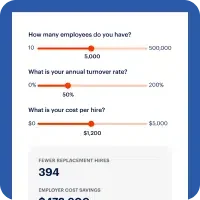THE COSTS OF ABSENTEEISM
Employee absenteeism isn’t cheap. According to a study done by Circadian, absenteeism among hourly workers costs $2,660 per employee per year. For companies employing 500 hourly workers, that amounts to $1,330,000 per year in direct absenteeism costs.
This number climbs higher if you employ shift workers for a 24/7 business like contact centers, where the average absenteeism rate is upward of 11%. At that rate, a 500-employee company would lose $2,400,000 simply dealing with absenteeism and its ripple effects.
If the contact center in question could reduce their absenteeism to 5%, they would save approximately $762,000 per year. At an average $30,000 p/year income, those savings equate to not hiring 25 new operators.
A TAXONOMY OF ABSENTEEISM
The thing to keep in mind is that Absenteeism is not a monolithic force with which to do battle. There are many types of absences. If you can understand this taxonomy, you can start to gain traction on small wins as you tackle the bigger issues at play.

This first category of absences are workplace related and are therefore in your domain to address.
1. Chronic tardiness and partial shifts
You know it well. Getting to work late. Leaving early. Taking outsized breaks. In absenteeism-speak, this is the death of a thousand papercuts.
How to Deal With It
When dealing with chronic tardiness, be sure to identify the problem early. By recognizing the trend before it becomes a big issue, you can help the employee identify the behavior before it becomes a habit. Reacting early also prevents your own impatience from clouding the interaction.
Simply verbalize your disappointment and explain the consequences their actions have on their coworkers. Connecting the dots from behavior to social pressure can go a long way. Remember to clearly state the consequences—such as making up hours, docking pay, or decreasing any bonuses—and also to reinforce through praise when the issue is addressed.
And don’t hog the conversation. Non-work-related obligations may be the root cause, e.g. family obligations, illness, or injury. If your employee explains that their chronic tardiness is not a simple fix for them, then maybe you can agree on a more flexible schedule.
Also, offering DailyPay to hourly workers is a great way to encourage timeliness—our partners have seen their DailyPay users voluntarily increase weekly hours by an average of 11%.
2. Burnout
Stressed and overworked employees—especially those who don’t feel appreciated—look forward to the weekend more than most. Add just a dash of personal stress on top of their current workload, and you’ve got the makings for impromptu, unsanctioned mental health day.
In a study from the CDC, about 40% of workers across industries classified their job as highly stressful, and 25% reported their job as the most stressful part of their life.
How to Deal With It
Stress and burnout is a conversation best broached by employers—overworked or stressed employees might be too worried about job security to suggest that they’re having a hard time.
It may seem counterintuitive, but encouraging breaks can make workers more productive in the long run.
In a study from the University of Illinois, psychology professor Alejandro Lleras explains:
“…Deactivating and reactivating your goals allows you to stay focused,” he said. “From a practical standpoint, our research suggests that, when faced with long tasks (such as studying before a final exam or doing your taxes), it is best to impose brief breaks on yourself. Brief mental breaks will actually help you stay focused on your task!”
On a macro level, monitoring workloads and shifting from heavy to moderate and back to heavy can have a similar effect. Heavy workloads encourage focus and flow states, while moderate workloads allow room for creative thinking and problem solving.
3. Passive disengagement
Employees who lack motivation in their jobs and feel no sense of loyalty or responsibility to their employers or coworkers are certainly more likely to miss work. Measuring absenteeism among these employees is tricky, because it’s possible that even when they’re there, they’re only partially there.
4. Active disengagement
By which we mean job hunting. Because job interviews happen during business hours your actively disengaged employees will have to fake an illness or something to clear their schedules.
How to Deal With It
Disengagement is the flip-side of the burnout coin. It usually happens when employees start to feel like their work is unimportant and/or they are just a number in a mass of employees. Re-engaging the disengaged is crucial to reducing both absenteeism and turnover.
RELATED READING: The 3 Levels of Employee Engagement & How They Affect Your Bottom Line
Every company and individual requires unique solutions to get the same outcome. However you choose to address disengagement, recognize that the strategies are to change an attitude, not a behavior.
These are the four positive attitudes that are critical to employee satisfaction and a healthy work culture.
A hopeful attitude generates high levels of agency (goal-directed energy) and plans to meet goals,
e.g. ask about their career goals and assign them additional work that supports those goals.
An optimistic attitude comprises a positive expectation about the future.
e.g., showcase opportunities to move within the company, to do work that is more interesting or fulfilling.
A self-efficacious attitude involves “a conviction/confidence about one’s abilities to mobilize the motivation, cognitive resources, or courses of action needed to successfully complete one’s tasks and responsibilities.”
e.g., be generous with praise and quick to acknowledge wins and hard work.
A resilient attitude is demonstrated through “positive adaptation in the context of significant adversity or risk.”
e.g., gently push employees out of their comfort zone in areas that align with their career goals.
Category 2 Absenteeism includes the types of absenteeism you can influence, but it’s harder to control the variables in the way you can for Category 1.
5. Bullying
Like any bullied school kid who feigns illness to avoid torment, a hostile work environment—whether it be verbal, physical, or sexual in nature—can go a long way in keeping your employees in bed in the morning.
The tricky thing about bullying and harassment is that the attacks can come in the form of microaggressions that are difficult to convict, and victims are often unwilling to bare their experience.
And it’s not just absenteeism that you have to worry about with regard to bullying. In a study of over 1,000 U.S. adults conducted by the Center for Generational Kinetics and Ultimate Software, 6 out of 10 respondents reported that a lack of emotional safety at work would make them quit a job immediately.
How to Deal With It
Addressing bullying and microaggressions in the workplace starts with company culture, which is no small task to change.
But if HR, managers, and the C-Suite can make an effort to openly discuss sexual, racial, and other types of aggression, then employees will feel empowered to discuss it as well.
Encourage your employees to speak out against aggressors and to document instances of harassment. Publicize an open-door policy for complaints and a zero-tolerance attitude toward inappropriate behavior. The key here is to assure all employees that you will come to their defense.
6. Depression
According to the National Institute of Mental Health, the leading cause of absenteeism in the United States is depression. I put it under Category 2, but really, it’s more like a Category 2.5, straddling the line between something you can influence and something you can’t.
Depression can lead to substance abuse if people try to self-medicate their pain or anxiety. Much like bullying and harassment, employees will generally be reluctant to open up about their experience, and in many parts of the country, depression is still stigmatized.
How to Deal With It
First, you have to know how to spot it. When an employee is at work, is he:
- Forgetful?
- Lacking focus?
- Indecisive?
- Irritabile?
- Uninterested in work or socializing with colleagues?
- Tired or fatigued?
You can’t solve their problems. Managers are not counselors; they are there to discuss performance and behavior. But you are also there to care about their wellbeing.
Lead with this concern in your conversation, then shift to pointing out observable behaviors—such as absenteeism—and acknowledge that this is different from their usual behavior.
Listen to how they explain the change, and be prepared with ready recommendations for counseling and healthcare options. It could help in the long run to allow temporary dispensation hours for counseling appointments until they can settle their work and medical care schedules.
End the conversation by reinforcing both your concern for their well-being and their work performance.

A mix of absentee-types, some of which you can influence and others you must simply accept and try to accommodate.
7. Illness & Injury
The most commonly reported reason for missing work (though not always the actual reason) is illness and medical appointments. The usual illness-absenteeism rate unsurprisingly spikes in cold and flu season.
Acute injuries can happen at work or not and can be the result of negligence or pure circumstance. In addition to acute injuries, chronic injuries—like back and neck problems—and overuse injuries can arise in every job, whether you work on a loading dock, behind the wheel, or at a computer.
How to Deal With It
The old self-help axiom says, “You are the average of five people you spend the most time with.” By offering solid health benefits and implementing a variety of employee wellness benefits, you can raise the tide of healthful behavior across your company.
By improving lifestyles, employees boost their immune systems. The fewer employees who get sick lowers absenteeism and reduces the odds of contagion in the office. And regular physical activity and fewer extended periods of sedentary behaviors can lower risk of injury.
Low-cost means for achieving this end include:
- Offering standing desks.
- Holding walk-and-talk meetings.
- Forming company fitness group, e.g., a weekly after-work yoga group or morning running group.
- Hosting on-site vaccinations.
- Throwing an Annual Wellness Day, which could include things like healthy eating class, catered lunch, on-site chair massages.
- Strategizing with local fitness and wellness organizations (gyms, spas, etc.) for group discounts.
The benefits of the above strategies go beyond health: they also prevent burnout, help fight depression, and can engender a greater sense of community among your employees.
8. Childcare and Eldercare
Practically in a category of difficulty all its own: obligations to miss work to stay home and take care of a child/elder when normal arrangements have fallen through (for example, a sick caregiver or a snow day at school) or if the dependent is ill or hurt.
How to Deal With It
Work-life balance is essential in combating depression, burnout, illness, injury, and disengagement. When a loved one is sick, work-life balance becomes much more difficult to achieve. For hourly workers, this poses a serious dilemma because taking time off reduces income in a time when that money is most precious.
According to the Family Medical Leave Act (FMLA), if your business has more than 50 employees within 75 miles, employees are allowed to take time off to care for their child or immediate family members as needed. FMLA covers employees for 12 weeks of potential leave within a calendar year. Though employees may typically take larger chunks of time, caregiver employees may benefit from using FMLA over the course of the year in the form of a few hours or few days at a time.
If it’s appropriate for a given role, definitely consider making flexible work-from-home arrangements to avoid taking on additional employees.
And for your employees’ financial well-being, offering DailyPay is a great way to help caregiving employees stay ahead of bills and overdraft fees.
Tight financial situations beget tighter financial situations. For instance:
- 34 million adults pay credit card bills late.
- 28.4 million households pay one bill late per month—usually a utility bill—which incurs them, on average, a $38 fee.
- In 2017, consumers paid $34.3B in overdraft fees, though the vast majority of people who are charged these fees deposit money into their checking accounts within three days of being charged.
Having ready access to funds, regardless of official paydays, is an essential ingredient to staying ahead. Though you can’t pay employees for hours they haven’t worked, offering DailyPay can help them avoid paying for those missed hours.














